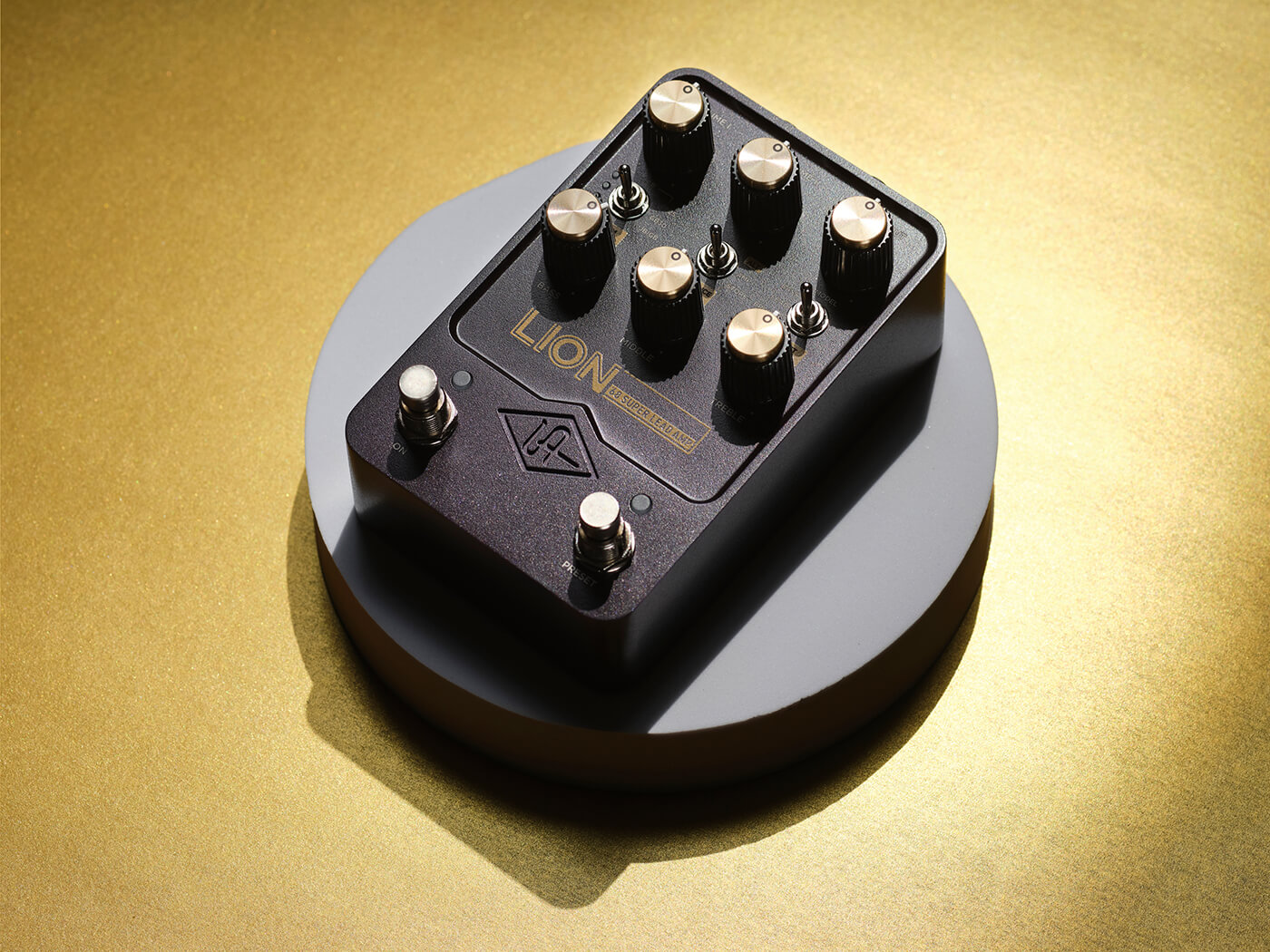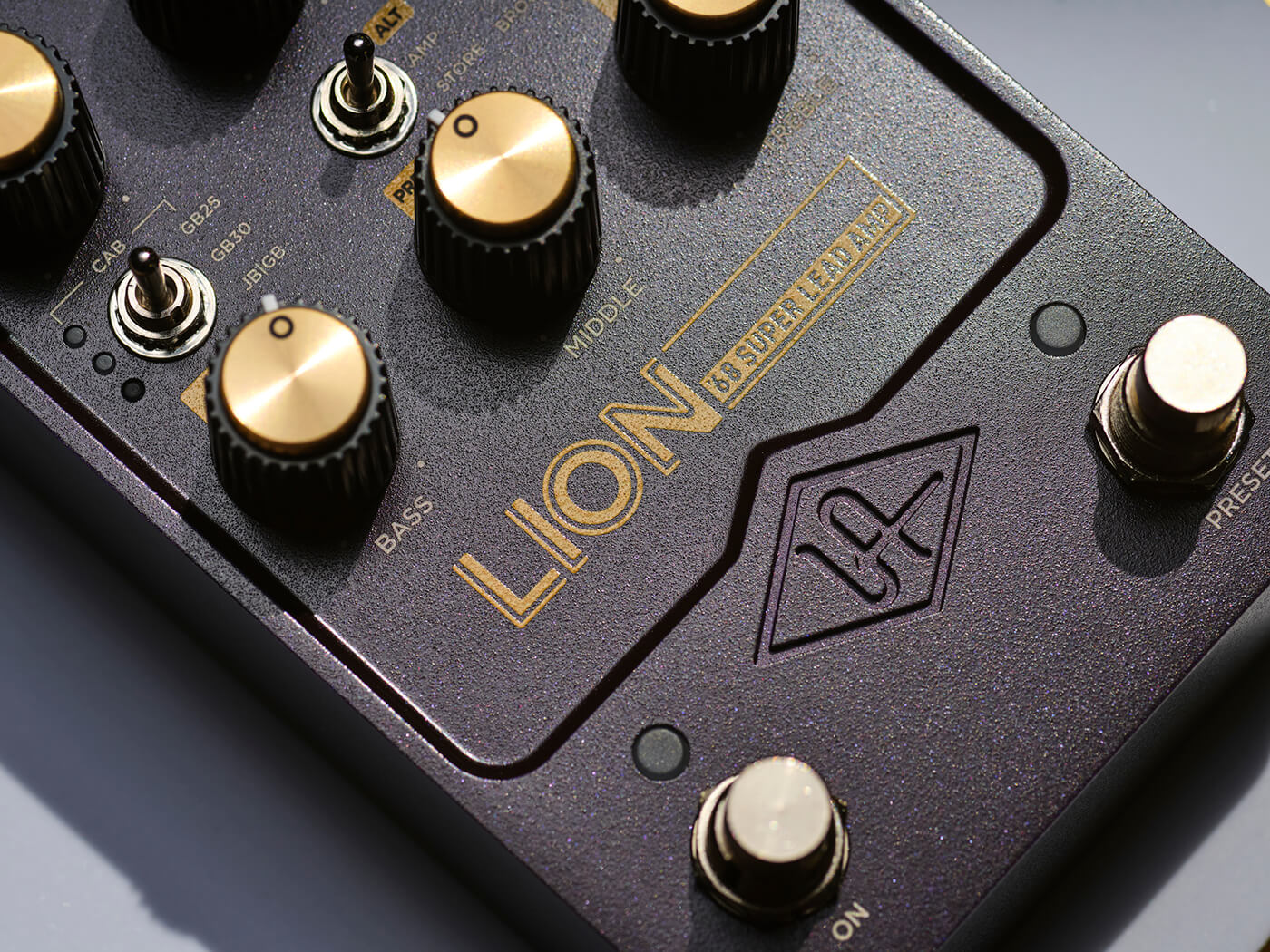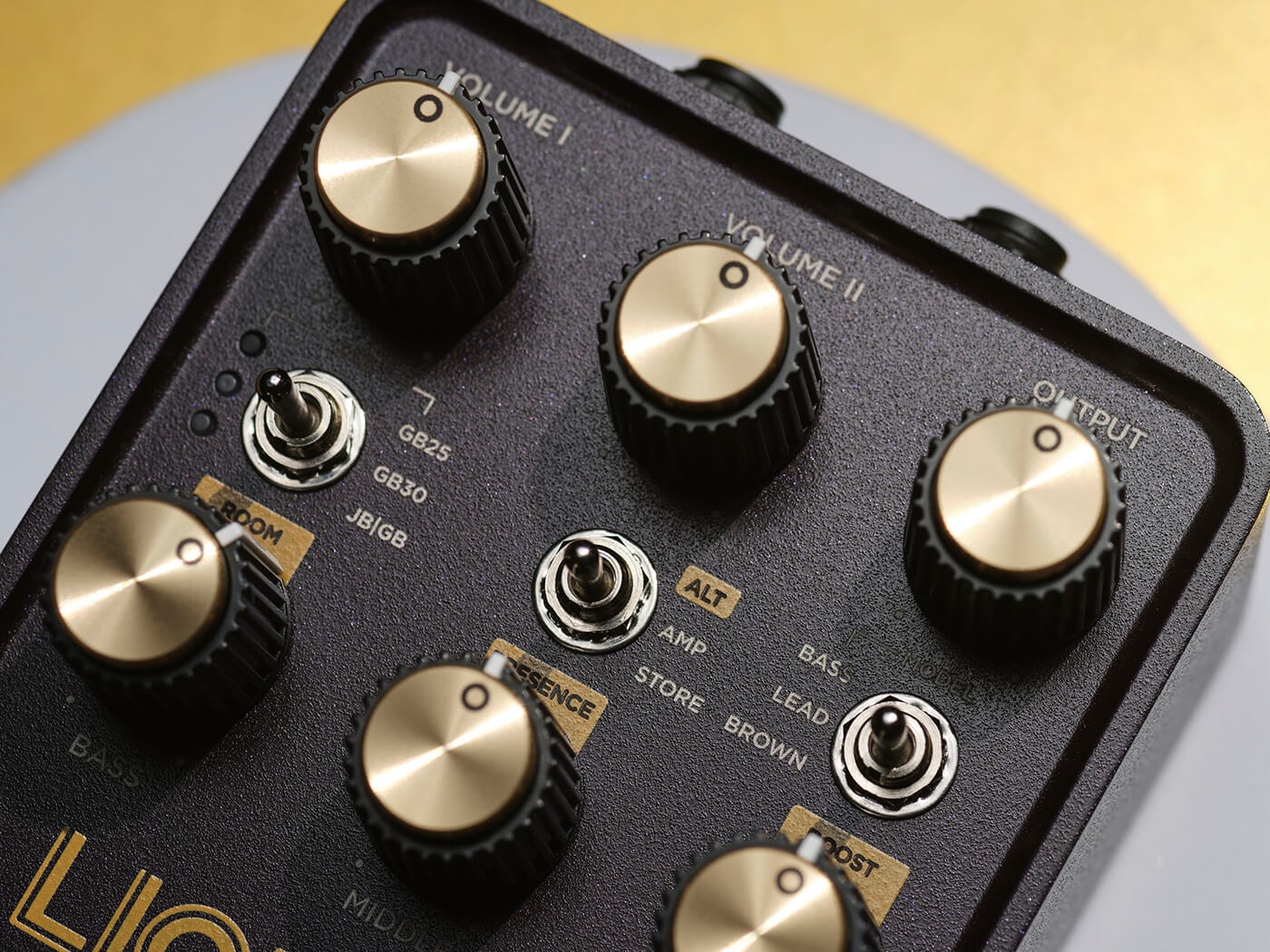Related Tags
UAFX Lion Review: UA’s most raucous amp pedal yet delivers the goods
If you know what you want, and what you want is a Marshall in UAFX amp pedal form, then the Lion is for you.

UAFX Lion. Image: Adam Gasson
Review Overview
Our rating
8
Our verdict
Good news, everyone! No longer shall UAFX fans be chained with a trio of (virtual) small combo amps, deprived of the (virtual) trouser-shaking action of a (virtual) half-stack! Because the Lion is here, and it’s sauntering into frame with three Marshall Plexi heads in its jaws. Is it ready for its big debut in the MGM logo, or is it time to phone the local dentist and get him to find his compound bow?
The Lion’s arrival fills a notable gap in UAFX’s initial trio of amp pedals. The Dream and Ruby modelled a Fender Deluxe Reverb and Vox AC30 respectively, two amps famous for pedal-platform perfection. Hence both are still dual-locked to scores of Instagram-ready Templeboards, patched into stacks of low-gain overdrives and Strymons.
But oh, the poor little Woodrow – destined to be the outlier from the off. Modelling a 1955 Tweed Deluxe, it collapsed into saggy fuzz at the first hint of action anywhere near its input jack. A great sound, sure, but a really specific one, which maybe explains why it’s now harder to spot in the wild. The more obvious thing, especially now that it’s happened, would have been for UA to complete the classic trifecta of Fender, Vox and Marshall – the three Unbroken Eternal Pillars of Rock Guitar Tone.
Yes, you could still get big rock tones with the Dream and Ruby. But boosting a small combo is a far cry from the roar of a 100-watt Marshall. UAFX stuff wasn’t quite as suited to closing your eyes and imagining you were blasting the ears off thousands of wasted hippies at Madison Square Garden in 1976. That is, until now!
Does the UAFX Lion sound good?
So, let’s not beat around the bush any further: my first test is to set everything to noon, load the Super Lead and the ‘stock’ cab (a Greenback-loaded basketweave 4×12), plug in a Telecaster Deluxe and hammer out a big low-E power chord. And look, this particular experience is worth the price of admission alone. It’s just THAT good. If you want the sound and feel of a paint-strippingly loud Marshall – albeit one mic’d up in another room – the UAFX Lion will deliver in spadefuls.
There are three discrete amps modelled here, organised in order of hairiness. You have the Super Bass, its gainer and bitier evolution the Super Lead, and finally the “Brown” amp – in the tradition of EVH, a modified Super Lead running through a variac for extreme saturation. All of them sound good, with the Super Lead being the most versatile – although the big, round cleans of the Super Bass were also fantastic. The Brown sound is good at it’s main EVH party trick, although it was a little too compressed for my ears in most other situations.

But each of the three has their strengths, and together they provide a good broad overview of the Plexi sound. Headphones (and arguably even FRFR monitoring) cannot replicate the chest-thunk feel and string interaction of a working amp throwing real SPL at you – but the rest is there. The compressed, biting attack at the front of a note. The big, clear rock ‘n’ roll sustain that eats up bluesy riffs. And, when engaging the Echoplex-voiced boost and dimming the channel volumes, the almost square-wave fuzz as the virtual power amp completely collapses. The sounds are dead-on, and the playing feel is spectacular.
If you do want to push out some actual dBs, you can disable the cab sim and run it into a power section of a ‘real’ amp, essentially replacing your preamp with that of a Marshall. I did this with an Orange head and a V30-loaded 2×12, and this too was great fun. Feedback-squeals, floor-shaking low notes: it’s enough to make you start babbling on about the ‘real spirit of rock ‘n’ roll.’
Let’s get back to running direct, though, for the sake of both my neighbours and testing out the cabinet simulation. The pre-loaded cabinets cover a variety of classic Plexi pairings, but my personal favourite was the de-facto ‘stock’ cab – that Greenback-loaded basketweave 4×12. It was just a good match – admittedly maybe just because I’m so used to the sound. Upon registering the pedal, you get another three cabs, bringing the total to six: you’re likely to gel with at least one of them.

Does the UAFX Lion take pedals well?
Running other pedals into the Lion is a broadly positive experience. It takes a Distortion+, an octave fuzz and a RAT like a charm. The Distortion+ leads to a great do-it-all rock tone, the octave fuzz Hendrixes more than a truckload of white Stratocasters bursting into flame and the RAT does the Kill ‘Em All thing, along with some less scrappy higher-gain stuff. Mission accomplished on the “taking pedals” front, I’d say.
In terms of non-drive pedals, this is a treat too: putting a tape-voiced delay before or after the Lion are both particularly awesome sounds, especially the former’s lovely little sojourn down shoegaze alley for this very classic-rock focused review.
It is worth noting that, when really slamming the input, I do get some audible digital clipping. This is likely due to the unavoidable fact that, despite the stellar sounds, this ain’t a real amp: at some point, signal has to go through an analogue-digital converter, which won’t have infinite headroom, and when you hit that headroom it’s going to clip.
But that’s not a huge deal – it just means re-thinking how you run your drive pedals. IE, not with the volume on maximum. And, really, you have to be pushing some silly dBs of signal into the Lion to hear that digital clipping – well beyond any reasonable levels of boost or saturation you’ll need. So, if you, like me, run your pedalboard set for a tube head into the Lion and it sounds clippier than a copy of Microsoft Word 97, maybe just take a second to roll a couple of volume knobs down and see how you go.

The familiar concerns
While UA may be world-class in its digital audio, the Lion doesn’t really do anything to rectify the long-standing issues with the whole UAFX range. So, if you already own a UAFX amp pedal, these issues won’t be anything surprising: you know what the format’s limitations are, and the Lion is a (very successful) Marshall version of that format. But if you’re yet to enter the UAFX universe, here are the hurdles you will encounter.
If you remember my OX Stomp review, you’ll know that I found the UA Control app experience no less enjoyable than a root canal. But thankfully, the app isn’t a workflow killer here: most of the Lion’s controls are on the actual pedal (revolutionary stuff), you only need the app to toggle the bright cap and the ‘ghost note’ mod, and adjust the jumpering of the channel inputs and the footswitch behaviour.
But you know what, UAFX: you’re going to need a bigger carrot to make me open that app any more than I absolutely have to. As with the Ox, it would disconnect seemingly at random, or if I locked my phone – although a software update has made this slightly better, it was still a problem. So in the small window of connectivity I had, I established where I liked all of those options with a bit of testing, and then never opened the app again. Hooray!
Other bad stuff: there’s still the mildly egregious absence of a desktop app, the slightly less egregious (but still quite egregious) absence of any XLR connectivity, and the very egregious absence of a headphone jack. In the face of all this egregiosity, the presumed defence is: you’re shelling out $400 for a single-purpose amp modeller, you’ve got cash to burn (or have already burnt the cash) on a nice DI box and/or some way to interface it into headphones. Can’t really argue with that, but it is indicative of the slightly laissez-faire attitude UA has to your spending.

Basically, it’s hard to judge a product’s value for money while also presuming an infinite budget for accessories. “This push-bike can hit 70mph on the motorway, presuming you invest in the small upgrade of a Kia Sorento and some rope,” and so on. $400 is not cheap for any guitar product, especially when multi-amp modellers with suites of effects and better connectivity can be had for a similar price.
But there are players who’ve been clamouring for this: the ones holding out for something a little more rock than the Dream or Ruby, or the ones who just want to expand their arsenal of UAFX gear, already prepared for the limitations. Why?
Well, it’s UA: for all the UAFX series’ quirks, the sounds are unarguably without peer. They remain so with the Lion.
